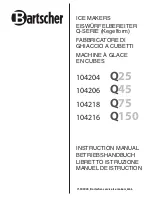
The electrical components in operation during
the freezing cycle are:
COMPRESSOR
FAN MOTOR (in air cooled version)
WATER PUMP
and during the timed phase of freezing cycle
(Time mode) they are joined by the
ELECTRONIC TIMER
On the air cooled versions the refrigerant head
pressure is gradually reduced from a value of
approx. 10 bar (140 psig), generally recorded at
the beginning of the freezing cycle with the unit
at 21
°
C (70
°
F) ambient temperature, to a minimun
value of approx. 8 bar (110 psig) just at the end
of the freezing cycle few seconds before the
starting of the defrost cycle.
The declining of the pressure is subordinated to
the reduction of the evaporating pressure, caused
by the progressive growth of the ice thickness
into the inverted cup molds and to the flow of air
drown through the air cooled condenser by the
fan motor.
The above values are in relation as well to the
ambient temperature of the ice maker site and
they are subject to rise with the increase of this
temperature.
On the water cooled versions the refrigerant
head pressure is stable at 9 bar (125 psig) being
controlled by a water regulating valve.
With the unit installed in a normal location (21
°
C
ambient temperature) at the start of the freezing
cycle the refrigerant suction or lo-pressure lowers
rapidly to 1 bar (14psig) then it declines gradually
- in relation with the growing of the ice thickness
- to reach, at the end of the cycle, approx. 0
÷
0.1
bar (0
÷
2 psig) with the cubes fully formed in the
cup molds.
The total length of the freezing cycle ranges from
20 to 22 minutes.
DEFROST OR HARVEST CYCLE
As the electronic timer has carried the system
throughout the third phase of freezing cycle or as
soon as the second phase T2 is over (when its
length has been as long as 35 to 45 minutes) the
defrost cycle starts.
DIP SWITCH
1
2
3
4
5
6
7
8
9
10
Air Cooled
ON
OFF
OFF
OFF
ON
OFF
ON
ON
ON
OFF
Water cooled
ON
OFF
OFF
ON
OFF
OFF
ON
ON
ON
OFF
TAB. A
DIP SWITCH KEYS FACTORY SETTING COMBINATIONS
NOTE.
The length of the defrost cycle (not
adjustable) is related to the length of the
second phase of freezing cycle T2 as detailed
in Table B.
The electrical components in operation during
this phase are:
COMPRESSOR
WATER INLET SOLENOID VALVE
HOT GAS SOLENOID VALVE
WATER DRAIN VALVE
and
WATER PUMP for the first 15 seconds.
The incoming water, passing through the water
inlet valve and its flow control (Fig. C) runs over
the evaporator platen and then flows by gravity
through the dribbler holes down into the sump/
reservoir.
The water filling the sump/reservoir forces part of
the surplus water from the previous freezing
cycle to go out to the waste through the overflow
pipe. This overflow limits the level of the sump
water which will be used to produce the next
batch of ice cubes.
Meanwhile, the refrigerant as hot gas, discharged
from the compressor (Fig. D) flows through the
hot gas valve directly into the evaporator
serpentine by-passing the condenser.
The hot gas circulating into the serpentine of the
evaporator warms up the copper molds causing
the defrost of the ice cubes. The ice cubes,
released from the cups, drop by gravity onto a
slanted cube chute, then through a curtained
opening they fall into the storage bin.
The water pump remains in operation, during the
first 15-20 seconds of the defrost cycle, to pump
out, trough the opened water drain valve, the
remaining water (reach of minerals and deposits)
of the previous freezing cycle.
NOTE.
The length of the defrost cycle (not
adjustable) changes in accordance with the
duration of the second portion of the freezing
cycle T2 .
At the end of the defrost cycle, both the hot gas
and the water inlet valves close and the machine
starts again a new freezing cycle.
Page 12
Summary of Contents for DX 40
Page 1: ...DX 40 Service Manual Cod 71503041...
Page 12: ...Page 11...










































